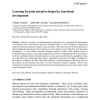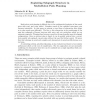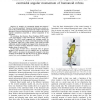208 search results - page 21 / 42 » How can a robot have consciousness |
AR
2007
13 years 7 months ago
2007
Joint attention is one of the most important cognitive functions for the emergence of communication not only between humans but also between humans and robots. In the previous wor...
AR
2006
13 years 7 months ago
2006
Cognitive scientists and developmental psychologists have suggested that development in perceptual, motor and memory functions of human infants as well as adaptive evaluation by ca...
JAIR
2008
13 years 7 months ago
2008
Multi-robot path planning is difficult due to the combinatorial explosion of the search space with every new robot added. Complete search of the combined state-space soon intracta...
ICRA
2007
IEEE
14 years 1 months ago
2007
IEEE
Abstract— A number of conceptually simple but behaviorrich “inverted pendulum” humanoid models have greatly enhanced the understanding and analytical insight of humanoid dyna...
ICRA
2010
IEEE
13 years 6 months ago
2010
IEEE
— Passively adaptive and underactuated robotic hands have shown the potential to achieve reliable grasping in unstructured environments without expensive mechanisms or sensors. I...



